In previous posts, I’ve discussed the economic challenges facing Montgomery County: stagnant wage growth, an aging workforce and increasing poverty. I’ve also highlighted our assets, including high incomes, low unemployment and a highly educated workforce. I’ve pointed out that high housing costs are the result of limited supply and that both businesses and residents of all ages prefer neighborhoods that look and feel “urban,” even if they aren’t located near transit or in major city centers. I hope that I have been successful in showing how and why real estate development is essential to economic development. In particular, the supply of housing (at every price point and including both subsidized/regulated projects and market-rate units) is crucial to attracting and retaining the mix of workers needed to make our economy strong.
Over the past decade, we have been updating master plans in dense urban centers like Bethesda and encouraging redevelopment of aging suburban shopping centers in places like White Flint and Montgomery Village. We’ve learned that we can apply certain lessons learned from cities to suburban development. We often refer to this practice as “New Suburbanism.”
It’s only a slight oversimplification to say that New Suburbanism is about a combination of three key ingredients:
- Walkability (and bikeability)
- Mix of uses
- Compact neighborhood form
Often these elements are incorporated into transit-oriented development, but they are relevant even in areas that do not have access to high-quality transit. On the other hand, not all transit-oriented development qualifies as New Suburbanism. Each of the three elements has to be incorporated in ways that are mutually reinforcing to produce better communities.
For example, sidewalks help to make an area walkable, but a mix of uses – such as retail, offices and government services — in close proximity to each other may be even more important to make walking a practical and attractive proposition. The combination means that residents can easily walk to basic services, like restaurants and stores, and if they choose to drive instead they don’t have to go far. A compact form of development means that space is used efficiently instead of encouraging dispersed development. These basic principles interact with each other and, when used correctly, create places that attract people and activity.
Pike & Rose, the North Bethesda development built to replace the aging Mid-Pike Plaza shopping center on Rockville Pike, is less than half a mile from a Metro station. This mixed-use hub is a good example of all the features we want to see in New Suburbanism, transforming an aging strip mall into an active, walkable and mixed-use community.
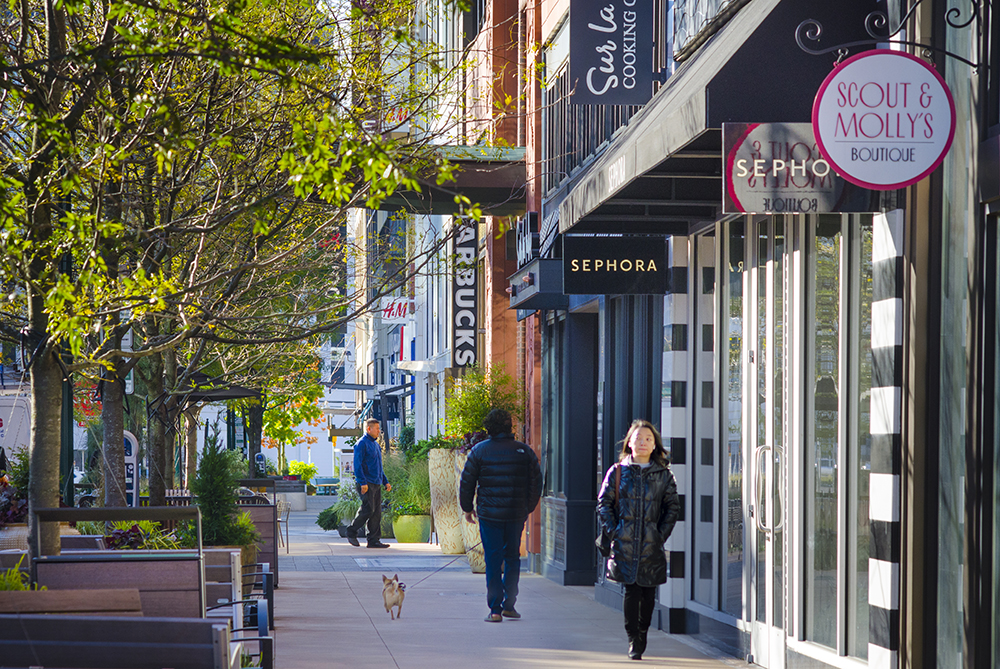
Pike and Rose, Photo courtesy Federal Realty
Pike & Rose illustrates some of the details that make the elements of New Suburbanism most effective. Short blocks, narrow traffic lanes to calm automobile traffic, bike lanes, street crossings that are easily managed by pedestrians, buildings that line the street instead of sitting behind surface parking lots, street-facing windows and entrances, and attractive landscaping all contribute to make Pike & Rose an inviting place to visit and walk around. With residential and office space above retail and restaurants, it’s got a good variety of uses, and the buildings vary in height to add density without being overwhelming.
By contrast, here’s a streetscape in Tysons Corner that’s also close to a Metro station:
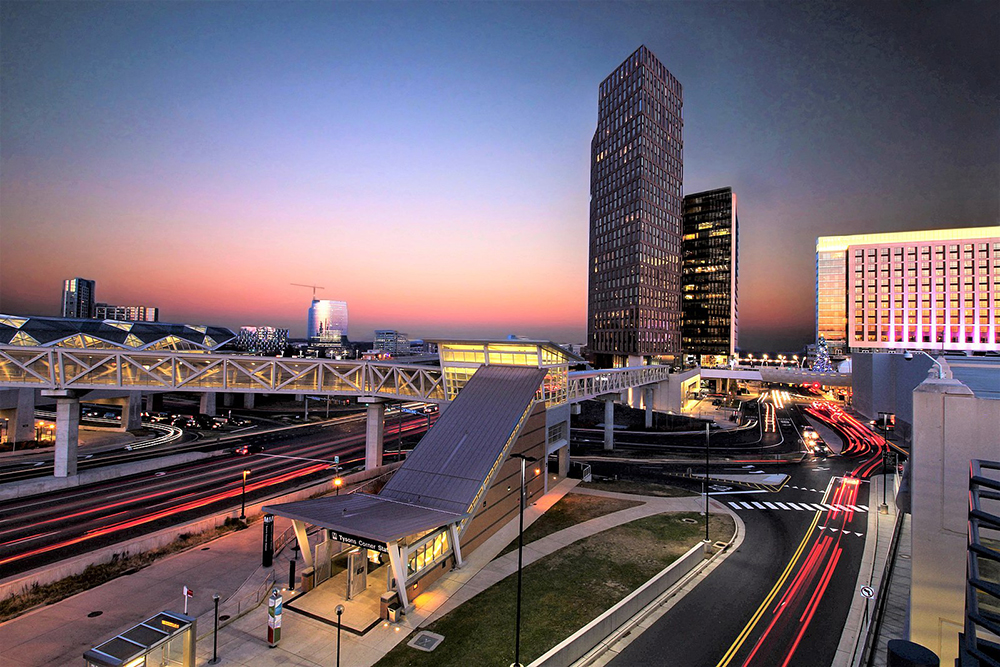
Tysons Corner Sunset, Photo by Joel D. Gray CC BY-SA 4.0
With the Silver Line in operation, Tysons Corner certainly benefits from access to a major investment in public transit. But it’s not an example of New Suburbanism – in fact, I would go as far as to say that it’s not really “transit-oriented development” – because it lacks many of the features described above. In fact, looking at this image it’s hard to imagine a less pedestrian-friendly experience. The tall buildings behind the Metro station have no apparent relationship to the ground plane, the station is surrounded by multiple lanes of traffic and there’s only one visible pedestrian crossing.
The dismal conditions for walking in and around Tysons Corner have been cited as one of the reasons Silver Line ridership has been lower than expected. Tysons Corner may become more walkable as new development projects take shape, but for now it shows why transit-plus-development does not always equal transit-oriented development (TOD). It’s certainly not what we’re trying to emulate when we think about how New Suburbanism can improve our economic competitiveness and quality of life.
Another example of development near transit that just doesn’t add up to TOD is New Carrollton.
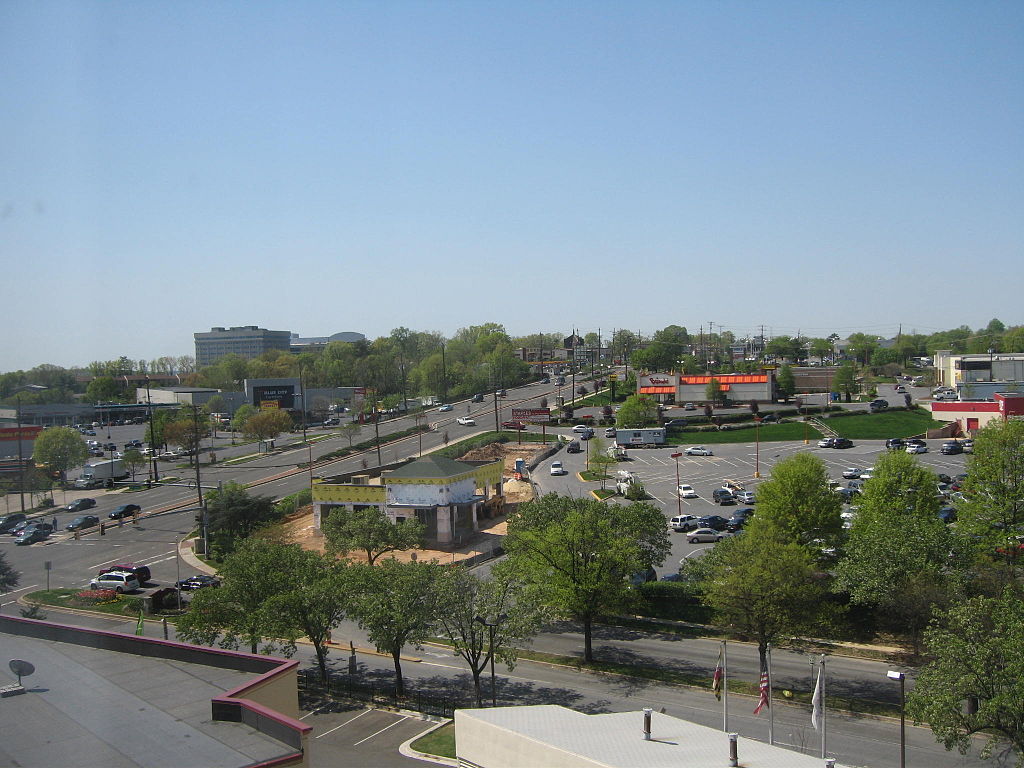
New Carrollton, Photo by Christopher Sayan CC BY-SA 3.0
With the Purple Line and new development on the way, this auto-dominated, sprawling development pattern can be corrected, but like Tysons, it’s got a long way to go.
A better model for New Suburbanism is Park Potomac, located just off I-270’s Exit 4:
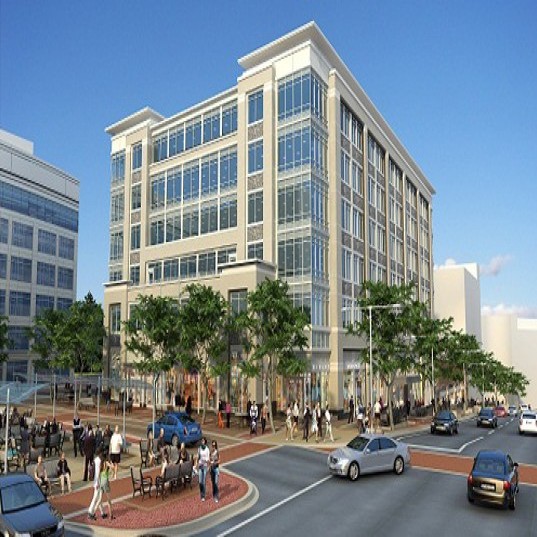
Park Potomac, Image courtesy Montgomery County Planning Department
Park Potomac isn’t transit-oriented, but it includes all the features we look for in New Suburbanism, even though a big part of its appeal is ready access to I-270. What’s important is that Park Potomac does a good job of adding housing and amenities in a setting that people and businesses prefer and at a scale that’s appropriate for the location. Even more importantly, it’s the kind of neighborhood where more and more people want to live and work.
A recent report found that hundreds of companies are moving to walkable urban places because that’s where their employees want to be – the disconnected, single-use office park of the past is no longer considered a viable alternative for a modern company that wants to attract a high-quality workforce.
At this point I should add that contrary to what some seem to think, New Suburbanist developments like Park Potomac are fully consistent with “smart growth” ideals even if they’re not located near transit. Compact, walkable communities with a mix of uses limit the environmental impact of development and reduce vehicle miles traveled, delivering on the objectives of smart growth even without transit.
The principles of New Suburbanism are flexible and can be implemented in both urban areas and suburban neighborhoods at different heights and densities. After all, whether you live in a high-rise apartment building, a townhouse or a single-family home, you should be able to walk or bike to nearby amenities and enjoy the benefits of a vibrant, well-designed public realm.
And we can apply the principles of New Suburbanism even at the smallest scale. Here’s a site plan image of a drugstore that commits all the familiar sins of auto-oriented suburban development:
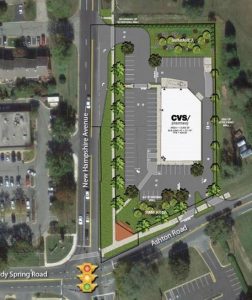
Image courtesy Montgomery County Planning Department
In this site plan, the building is surrounded by parking and doesn’t have any relationship to the street. But here’s a similar drug store project that uses walkable design principles:
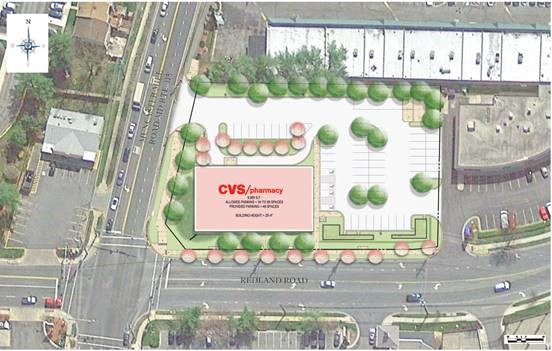
Image courtesy Montgomery County Planning Department
Simply moving the building to the street, providing sidewalks and landscaping, and locating the parking behind the store can completely transform a low-density infill retail project and help make a community more walkable and inviting.
Don’t get me wrong – I’m not saying that transit doesn’t matter. Transit is extremely helpful in facilitating the kind of development that improves quality of place, and the most effective way to reduce driving is by providing access to high-quality transit service. All other things being equal, development near transit is always better than development without transit. Our challenge is that we need to find ways to create environmentally sustainable, attractive and livable communities even where the density and scale of development needed to justify transit is neither currently present nor appropriate in the future.
I hope that in this series of posts I have shown why real estate development – including housing as well as office buildings – is important to Montgomery County’s economic health. The rating agencies that evaluate our financial strength and ability to repay our debts certainly understand this factor.
In renewing our triple-A bond rating last month, Moody’s cited the “likelihood that [Montgomery County’s] substantial and diverse tax base will remain strong given ongoing development and proximity to the District of Columbia” (emphasis added). In planning for this growth, we have an opportunity to distinguish ourselves from our competitors. By embracing New Suburbanism, we can create communities with a strong quality of place that will help us to retain and attract skilled workers and their employers. We can accomplish this goal while meeting the housing needs of our workforce and improving the quality of life enjoyed by all our residents.
In upcoming posts, I will turn to other aspects of planning for growth, including the impact of growth on public infrastructure, such as on schools and the environment.